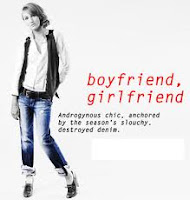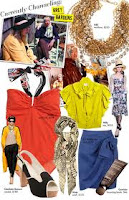29/10/10
Receshion
Could this be the next fashion buzzword?
Read the Recession Fashion selection of post and articles on Fashion English
Tweet
Heel heights grow during Recession
"We have entered a moment of heightened impracticality in footwear,"Elizabeth Semmelhack, author of "Heights of Fashion: A History of the Elevated Shoe" told CNN.
"Heel heights noticeably grew during the Great Depression of the 1930s, the oil crisis in the 1970s, and when the dotcom bubble burst in the 2000s."
The heel height in women's shoes has greatly increased in the present day.
Semmelhack believes the height increase demonstrates a need for escapism in hard economic times.
read more on: examiner.com
see also: Recession Fashion
Tweet
27/10/10
Chaoren
A Chinese term for youths at the vanguard of fashion.
Discussing the appeal of iPhones, iPads and the like, in The Global Times, Ding Gang spotlighted the term chaoren:
Chinese use the recently coined term chaoren, referring to those who stand at the front lines of fashion, with new clothes and amazing gadgets. The iPad has been every chaoren’s new toy since it entered the market.
published on Shott's Vocab
Tweet
Vintage
Last season's clothes are "used clothes". Vintage implies some kind of pedigree.
published on: NZ Herald News
Tweet
You
Telling someone whose style you like, "It's so you" is a compliment. If you don't like their outfit, it means, "I wouldn't wear that if you paid me." If this is too obvious an insult, you could say "unclassifiable" or "unique".
source: NZ Herald News
Tweet
Vanity sizing
published on: NZ Herald News
Tweet
Trickle-up trend
published on: NZ Herald News
Tweet
Trashic
published on: NZ Herald News
Tweet
T-shirtable
source: NZ Herald News
Tweet
Pickle-stabbler
Use it: Pickle-stabbers and pointy toes are so 20th century.
Source: NZ Herald News
Tweet
Retro-futurism
Use it: That shiny, silver bag is so retro. But, oh, it's kind of futuristic and space-age as well.
Wow, that must be the retro-futurism I've been hearing all about.
source: NZ Herald News
Tweet
On trend
So if lace dresses are popular, they are making or wearing lace dresses. You may wonder why we keep using such phrases if we realise some of them are so annoying. Well, you try coming up with 20 synonyms for fashionable and you'll understand.
Use it: There were some weird bits, but mostly her whole collection was so on trend.
Source: NZ Herald News
Tweet
Personalisation
Source: NZ Herald News
Tweet
Glamourista
Use it: Oh dear, look at her. With her Chanel bag and her Dior sunglasses she thinks she's such a glamourista.
Source: NZ Herald News
Tweet
Makeunder
Use it: My mother used this pudding bowl and scissors to give my hair a makeunder.
Source: NZ Herald News
Tweet
Covert couture
Source: NZ Herald News
Tweet
Bespoke
Note that there are big differences between bespoke and other similar terms. Bespoke is where it's made for you from scratch.
Source: NZ Herald News
Tweet
Black
So when something becomes so widespread it rivals the popularity of the colour black, it is referred to as the new black.
Source: NZ Herald News
Tweet
Aspirational
It's fashion as fantasy: This is also the best excuse ever invented by the fashion industry for the politically incorrect things they do.
Use it: We don't want 14-year-old girls to develop anorexia. Surely they can tell the difference between reality and fantasy. This is high fashion. It's aspirational.
Tweet
Fashionese shows a great love for blend words
Fashionese is also very fond of abbreviations, particularly fashion to 'fash' (as in fash pack, fash clash and so on) and of acronyms such as YSL (Yves Saint Laurent), MFW (Milan fashion week) and s/s (spring/summer fashion collections).
Fashionese may sound quite like English, but be careful, there are a number of false friends to trip up the unsuspecting fashion speak novice.
Watch out for 'very' (used to mean 'in the style of', rather than 'extremely'), 'nudes' (a natural skin toned colour palette rather than naked people), 'vanilla' (bland and boring rather than the flavouring) and 'beige' (again meaning dull or uninteresting rather than light brown coloured)
Source: Speak Fashionese
French words in Fashionese
Some French words and expressions are used correctly such as 'avec' and 'c'est magnifique' but more often than not English expressions are translated literally and consequently incorrectly such as 'très maintenant' (which is a literal, but grammatically incorrect, translation of 'very now' as in 'very trendy right now').
Some words are not only mistranslated but are also mispronounced such as 'haute' which is pronounced as 'hot' in Fashionese rather than 'oat' as in French, and used describe something fashionable as opposed to its original meaning, 'high', in French.
Source: Speak Fashionese
Tweet
Pinkwashing
 Using support for breast cancer research to market products, particularly products that cause cancer.
Using support for breast cancer research to market products, particularly products that cause cancer.Pinkwashing is a blend of pink, the color associated with breast cancer research, and whitewashing, "concealing flaws."
"An unflattering term coined by activists for pink products by companies that say they're helping fight breast cancer but are linked to practices that contribute to factors researchers say cause rising rates of the disease."
—Gabrielle Giroday, Think before you pink, Winnipeg Free Press, June 4, 2008
Published on: Word Spy
Tweet
25/10/10
Hoxton
 After the hipper-than-thou East London area, Hoxton has now become shorthand for its own particular breed of art-school edgy, particular if worn by a borderline anorexic boychild with asymmetric hair.
After the hipper-than-thou East London area, Hoxton has now become shorthand for its own particular breed of art-school edgy, particular if worn by a borderline anorexic boychild with asymmetric hair.See also: Shoreditch.
published on: shinystyle
Tweet
Conceptual

Impressive, decorative, but not strictly necessary.
published on: shinystyle
Tweet
Matchy-matchy

published on: shinystyle
Tweet
Boyfriend
 As a general rule, notwithstanding Vera Wang, the fashion industry doesn’t persecute single women to nearly the same extent as other institutions (TV, film, elderly aunts). But every so often even the staunchly autonomous world of style has a moment of weakness and makes us feel crap for being uncoupled. “Boyfriend” style is one of those moments. Used to make baggy, manly clothes sound appealing, the concept on boyfriend blazers, trousers etc is based on the idea that you might have borrowed them from a man’s wardrobe. What it overlooks, of course, is that if you actually borrowed said items from your boyfriend’s wardrobe, they would be too big on the shoulders, too tight on the hips and smell of feet.
As a general rule, notwithstanding Vera Wang, the fashion industry doesn’t persecute single women to nearly the same extent as other institutions (TV, film, elderly aunts). But every so often even the staunchly autonomous world of style has a moment of weakness and makes us feel crap for being uncoupled. “Boyfriend” style is one of those moments. Used to make baggy, manly clothes sound appealing, the concept on boyfriend blazers, trousers etc is based on the idea that you might have borrowed them from a man’s wardrobe. What it overlooks, of course, is that if you actually borrowed said items from your boyfriend’s wardrobe, they would be too big on the shoulders, too tight on the hips and smell of feet.published on: shinystyle
Tweet
Sit back
published on: shinystyle
Tweet
Channeling

There are several reasons that fashion folk use the word channelling so much. One is because it is, to all intents and purposes, another way of saying “copying” that sounds far more admirable and far less like primary school. Another is because it makes getting dressed sound like a form of superhuman act, like channelling the force of some radioactive crystals through our fingertips in order to create a rip in the space-time continuum. It makes it sound important, and fashion folk like feeling important.
source: shinystyle
Tweet
BIJ
published on: shinystyle
Tweet
Micro-Trend
published on: shinystyle
Tweet
Global Traveller Chic
 Global Traveller Chic is all about trippy colours and the kind of scraps of fabrics from Bangkok night markets that first-year university students think make fabulously chic wall-hangings.
Global Traveller Chic is all about trippy colours and the kind of scraps of fabrics from Bangkok night markets that first-year university students think make fabulously chic wall-hangings.The pseudo-ethnic hippy nonsense that even Jade Jagger tossed into the trash some years ago has come back to haunt us. If you see a girl a girl in acid yellow and a trustafarian bobbly hat, you're looking at GTC.
Published on The Guardian
Tweet
Candyfloss, butter chocolate, mint

So it's quite right that fashionese should have a similarly hopeful intention, even if in this case it's the hypothetical aspiration of the speaker to one day allow herself to eat the cited foodstuff (butter? Chocolate? Dream on, girlfriend), whereas blueberries are totally permissible superfoods and therefore aren't quite as thrillingly dangerous to mention. Going back to Prada, it is all about, as one far inferior newspaper put it with admirable eloquence, "deliberately alienating colours", which means orange, green and grey, which means "very tricky to wear".
source:
Tweet
Nu Tec
See also "burnt", "blistered", "puckered" and "bubbled", none of which, it has to be said, are adjectives one generally sees in a fashion context, but it's always nice to give all words their moment in the sun. And also "bleeding", which refers to colours blending into one another. The more medically slanted "bleeding" is more acceptable than the more common description of "tie-dyed" because hippies are tres passe these days - very 2004/5 as part of the hastily forgotten boho era.
Published on The Guardian
Tweet
Very Edie
Alternatives for those who don't fancy looking like an S&M mistress from Torture Garden or a batty prematurely aged housewife are "preppy" (anything with a blazer) or "skater style" (not an encouragement to dress like Christian Slater in the seminal 1989 film Gleaming the Cube, but the more Torvill and Dean-inspired ice-skater look, which should pretty much begin and end with fake fur-lined mid-calf boots, which are not, under pain of death, to be referred to as "booties".
That term should be reserved for slightly kinky, ie totally impossible to walk in, ankle boots.
Published on The Guardian
Tweet
Body con

Published on The Guardian
Tweet
Yet-buts
A yet-but is a hedge, a caveat, used when describing some discrete article of fashion: a dress, a shoe, a bag — whatever needs three lines of text to anchor the large picture, or a few words to fill out the caption: “boho yet elegant,” “futuristic yet primeval.”
The yet-but is a quirk of fashion writing that has gotten less attention than it should.
Published on: Boston Globe
Tweet
Nailphiles

Nail polish as the new recession cosmetics staple.
When a recession hits, we can usually count on two things: hemlines will hit the floor and women will stock up on lipstick. But during the recent global economic crisis, skirt lengths remained resolutely short and a new beauty product was crowned queen of the cosmetics counter.
Nail polish sales grew by a remarkable 14.3% in the U.S. in 2009, and were the only beauty category to experience double-digit growth, according to market research firm Kline and Company. Sales of lipstick and lip gloss, meanwhile, dropped by 5.3%, leading industry experts to believe that women have embraced nail polish as the new recession cosmetics staple.
So what’s made the ladies switch from lips to tips?
Read more: National Post
Tweet
19/10/10
Michelle Obama and Stock Market Fashion

October 18, 2010, 5:19 pm
By THE NEW YORK TIMES
In the Economix blog, our colleague Catherine Rampell writes that Michelle Obama’s public fashion choices can boost the stock price of the companies making her clothes: “That is the conclusion of an analysis by David Yermack, of the Stern School of Business at New York University, published by The Harvard Business Review. Ms. Obama wears an outfit, and in (oftentimes correct) anticipation that her get-up will become the latest New Thing, the company that makes those clothes gets a healthy boost in its stock price.”
Tweet
18/10/10
Lindsay Lohan Stock Index
published on: Investopedia
Tweet
Lipstick Effect
You can read more on Investoedia:)
Geek chic
Geek chic refers to the embracing of stereotypically unpopular "geek" characteristics such as glasses, comic books, and computer/video games.
"Are you a real geek? Are you proud of being a geekette? You can be cute (or sexy), yet embrace your geekyness by dressing in Geek Chick Style".
published on: wikihow
Going brow-less

According to makeup artist Pat McGrath -- who gives eerily similar quotes to both the Times and the Guardian -- it's all about the recession: "The current economic troubles open people up to be more daring and willing to don cutting-edge looks." The Guardian follows up on McGrath's comment with a reachy-feeling question: "At a time when advertising is suffering, is eyebrowlessness just a more extreme way for a brand to sell its products?" asks the article's author, Emma Sibbles. Interestingly, in its own attempt to pin the trend on the recession, the Times floats precisely the opposite query: "Could no eyebrows be a reflection of economic downturn? Can one be too poor to have them? Having no eyebrows is certainly a way to express oneself without buying a product
see also: Hemline Index
published on: Salon
Tweet
Hemline Index
Recent research suggests it is valid. The theory suggests that hemlines on women's dresses rise along with stock prices. In good economies, we get such results as miniskirts (as seen in the 1960s), or in poor economic times, as shown by the 1929 Wall Street Crash, hems can drop almost overnight. Desmond Morris revisited the theory in his book The Naked Ape and the theory was also the topic of a question on the BBC Panel Show QI in 2010.
Tweet
Gypset
Julia Chaplin ha anche scritto un libro su questo nuovo stile di vita intitolato GYPSET STYLE ed edito da Assouline.
pubblicato su: in-dies
vedi anche: Fashion's new favourite buzzword: gypset
Tweet
11/10/10
Jeggings
'Dozens of students were kicked out of class on the first day of term – for wearing jeggings. Furious parents have condemned Samuel Ward College in Haverhill, Suffolk, for its "draconian" ban on the fashion item. Jeggings are denim-style leggings made popular by celebs including Paris Hilton and Fearne Cotton.'
Published on The Sun 9th September 2010
more on macmillandictionary.com/buzzword
Tweet
04/10/10
Fashion forward
 Ahead of the trend, anticipating new/upcoming fashion trends.
Ahead of the trend, anticipating new/upcoming fashion trends.“By revealing his 'secret' to a few fashion-forward people and allowing them do the legwork, he created a textbook viral-marketing campaign."
(The Onion, Volume 24 Issue 29 article entitle "Divorced Branding Exec Generates Buzz Before Getting Back Out There")
Interested in fashion and wearing things that will soon become very fashionable
clothes for fashion-forward teenagers
More modern than things that are fashionable now
fashion-forward jeans
read more on: Dictionary Cambridge
Tweet




